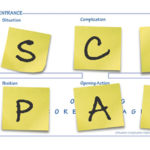Want better presentation results? Plan strategically, not tactically. Instead of recycling slides from older decks and making them fit your presentation, start with who your audience is and what you want to accomplish. Here’s how.
The way most people put together presentations these days is to go to an old slide deck and find slides that, with a little tweaking, can be reused. Then, they create any new slides that might be needed.
Finally, all these slides get moved around until they’re in the order that the speaker wishes to present them. This is the tactical approach to presentation planning. I don’t recommend it.
Use a strategic approach to presentation planning. You’ll get better results.
There are three stages to strategically planning an effective presentation:
-
- First, start with a clear view of who your audience is and what you want to accomplish with them.
- Then, clarify your core message and fill in the needed details.
- Lastly, add slides, stories, demos (if appropriate), or any other information that helps you explain your logic.
Here are some things to think about at each stage in the strategic presentation planning process.
Consider who will be in your audience and what’s important to them.
-
- What keeps them up at night?
- What is the issue they need to solve or be informed about?
- What is their attitude toward the topic? Positive, negative, or neutral? Is the audience split?
- What is their level of knowledge on the topic? Do you need to define acronyms or technical terminology?
Define what you want your core message to be.
-
- Net out what is sometimes called the “elevator pitch” or “executive summary.”
- Begin your presentation with this core message.
- Use a proven framework, like the Mandel Blueprint®, to build and present your core message.
-
- Include a statement of the problem from the audience’s point of view to set the context.
- Offer your opinion on what needs to be done.
- Make your “ask” of the audience.
- This should all happen in the first 90 seconds of your presentation.
Group presentation details around your main ideas or headings.
-
- Make your main ideas the content of your agenda slide.
- Limit the number of main ideas to three. It’s easier for the human brain to process and retain facts or information in groups of three. If you must include more, don’t exceed five main ideas.
- Keep the detail you provide to “must know” information.
- Put “nice to know” information in your handout package, appendices, or on backup slides.
Learn more about the Mandel Blueprint® or the ever-popular stand-alone SCI-PAB® framework. Or, explore our Corporate Communication Training Workshops, where we teach professionals how to expertly use these and other tools to up-level all of their communications, formal and informal.







